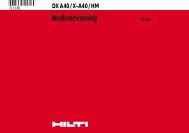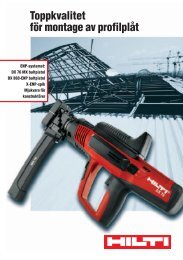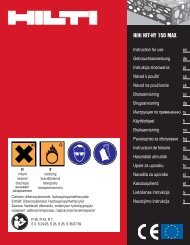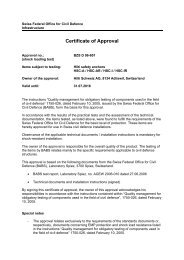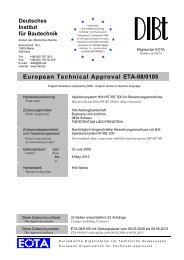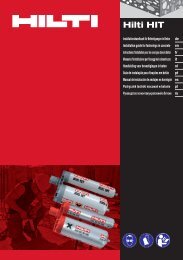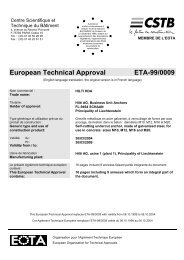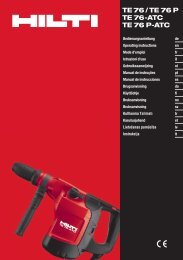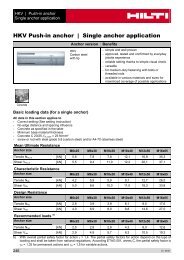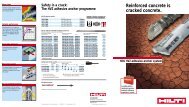00 Contents - Hilti Svenska AB
00 Contents - Hilti Svenska AB
00 Contents - Hilti Svenska AB
You also want an ePaper? Increase the reach of your titles
YUMPU automatically turns print PDFs into web optimized ePapers that Google loves.
Steel base material<br />
Surface of the steel base material<br />
Corrosion protection of structural steel is often achieved by hot-dip galvanizing. Tests have<br />
shown that if the fastener penetrates right through the steel, the galvanizing has no significant<br />
effect on pull-out strength. In the case of fasteners that do not through-penetrate, pullout<br />
strength is reduced by about 25 %. The summary of results from one test is shown<br />
below to illustrate these effects.<br />
Average ultimate pull-out loads<br />
Steel thickness 6 mm [0.236"] Steel thickness 20 mm [0.787"]<br />
Surface Number Surface Number<br />
Ultimate tensile strength of steel : fu = 430 MPa [62,366 psi]<br />
Surface of the steel : 1. Rough with some slag and rust (reference)<br />
2. Sandblasted<br />
3. Pickled + hot-dip galvanized (min. 60 µm zinc)<br />
Several important observations can be made based on these results:<br />
• Pull-out loads in 6 mm ( 1 /4") steel base material are much less affected by the surface condition<br />
of the steel than they are in 20 mm ( 3 /4") steel. The reason is that the main anchoring<br />
mechanism of through-penetration fastenings is clamping, which is not affected by the<br />
surface condition of the steel.<br />
• Hot-dip galvanizing appears to reduce the pull-out strength of non-through penetrating<br />
fastenings by nearly 30%. Note, however, that even with hot-dip galvanizing, the pull-out<br />
strength was still 12.5 kN (2.8 kips).<br />
• The negative effect of hot-dip galvanizing is explained by the tendency of zinc on the fastener<br />
to act as a lubricant that reduces heat generation during driving. This in turn reduces<br />
the tendency of the fastener point to fuse to the base steel. Zinc from the coating on the<br />
base steel apparently becomes attached to the fastener as it enters the base steel.<br />
For applications where tensile strength of the fastening is critical and the steel has a heavy<br />
coating, the fastening system can be qualified by carrying out pull-out tests on site. If pullout<br />
strength is not adequate, depth of penetration can be increased to improve the situation.<br />
11 / 2<strong>00</strong>7 1.39



